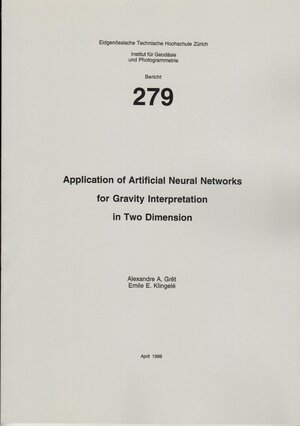
×
![Buchcover ISBN 9783906467108]()
Application of Artificial Neutral Networks for Gravity
Interpretation in Two Dimension
von Alexandre A Grêt und Emile E KlingeléIn applied geophysics generalized bodies are often used to represent the distribution of underground masses, as spheres, vertica1 cylinders, vertical prisms, horizontal cylinders, vertical faults, antic1ines and synclines. In the absence of any information regarding the shape of the target, the interpretation tends to be ambiguous. In this study Artificial Neural Networks are used to find the most probable model for a given anomaly. A network is trained with anomalies produced by two different kinds of disturbing bodies, producing similar anomalies. The trained Artificial Neural Network is then able to recognize the kind of body that is producing the given anomaly. They can have any possible dimension within the limits defined by the training parameters (e. g. depth, radius. ). It was found that with this technique the ambiguity between similar anomalies generated by different disturbing bodies can be solved without using densities.
In quantitative gravity interpretation many inversion techniques are used, all being heavy and restricted to experienced modelers. The inversion technique developed in this study using Artificial Neural Networks is very simple and remarkably precise. The average error of inversion of all bodies and parameters presented in this study lies by 2% and is never higher than 5%. The technique, strongly inspired by the gravity interpretation method by nomograms, is dealing with small and simple networks, it is therefore easy to leam and understand. U sing advanced training algorithms makes interpretation easier and less time consuming. Quantitative interpretation with Artificial Neural Networks is more difficult than qualitative, but with some experience ofthe method described in this study it can be applied easily.
Up to now there is no interpretation method available, which can, for example discriminate between an antic1ine and a sync1ine without any hypotheses about the shape or the density contrast of the target. It is shown here that this can be done by applying Artificial Neural Network for qualitative gravity interpretation. Classic inversion techniques are time consuming and sometimes difficult to apply, their capabilities depend on the geology and on the measured data. Inversion with Artificial Neural Networks is similar for all geological bodies used in exploration geophysics; its attitude of convergence is independent on the extension or density contrast of underground masses.
It is not the goal of this study to give a complete and general applicable interpretation technique. All applications developed in this work are based on synthetic data. They are a first step in the direction of a generalized technique of interpretation. Problem of inaccurate (noisy) data has to be studied and solutions have to be developed. Some solutions are suggested and ideas for further studies are described.
In quantitative gravity interpretation many inversion techniques are used, all being heavy and restricted to experienced modelers. The inversion technique developed in this study using Artificial Neural Networks is very simple and remarkably precise. The average error of inversion of all bodies and parameters presented in this study lies by 2% and is never higher than 5%. The technique, strongly inspired by the gravity interpretation method by nomograms, is dealing with small and simple networks, it is therefore easy to leam and understand. U sing advanced training algorithms makes interpretation easier and less time consuming. Quantitative interpretation with Artificial Neural Networks is more difficult than qualitative, but with some experience ofthe method described in this study it can be applied easily.
Up to now there is no interpretation method available, which can, for example discriminate between an antic1ine and a sync1ine without any hypotheses about the shape or the density contrast of the target. It is shown here that this can be done by applying Artificial Neural Network for qualitative gravity interpretation. Classic inversion techniques are time consuming and sometimes difficult to apply, their capabilities depend on the geology and on the measured data. Inversion with Artificial Neural Networks is similar for all geological bodies used in exploration geophysics; its attitude of convergence is independent on the extension or density contrast of underground masses.
It is not the goal of this study to give a complete and general applicable interpretation technique. All applications developed in this work are based on synthetic data. They are a first step in the direction of a generalized technique of interpretation. Problem of inaccurate (noisy) data has to be studied and solutions have to be developed. Some solutions are suggested and ideas for further studies are described.


